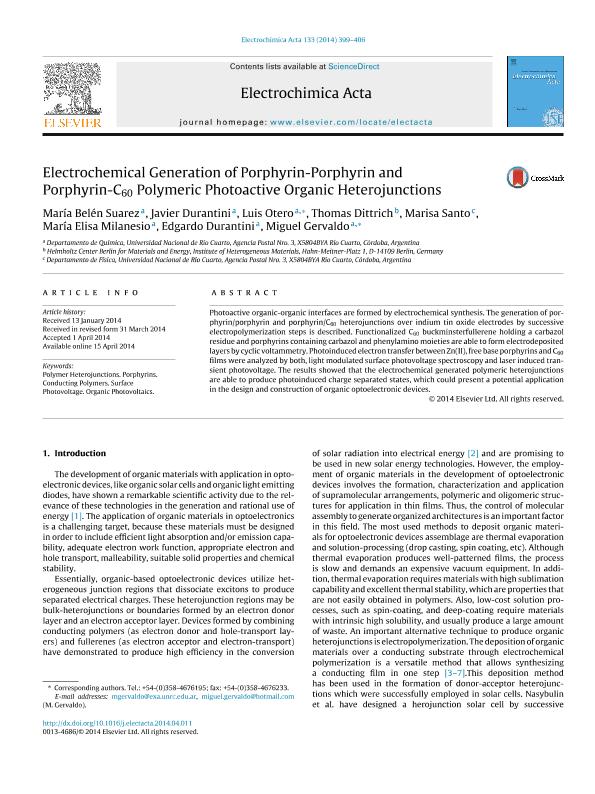Artículo
Electrochemical Generation of Porphyrin-Porphyrin and Porphyrin-C60 Polymeric Photoactive Organic Heterojunctions
Suárez Ramanzin, Maria Belen ; Durantni, Javier; Otero, Luis Alberto
; Durantni, Javier; Otero, Luis Alberto ; Dittrich, Thomas; Santo, Marisa Rosana; Milanesio, María Elisa
; Dittrich, Thomas; Santo, Marisa Rosana; Milanesio, María Elisa ; Durantini, Edgardo Néstor
; Durantini, Edgardo Néstor ; Gervaldo, Miguel Andres
; Gervaldo, Miguel Andres
 ; Durantni, Javier; Otero, Luis Alberto
; Durantni, Javier; Otero, Luis Alberto ; Dittrich, Thomas; Santo, Marisa Rosana; Milanesio, María Elisa
; Dittrich, Thomas; Santo, Marisa Rosana; Milanesio, María Elisa ; Durantini, Edgardo Néstor
; Durantini, Edgardo Néstor ; Gervaldo, Miguel Andres
; Gervaldo, Miguel Andres
Fecha de publicación:
04/2014
Editorial:
Pergamon-Elsevier Science Ltd.
Revista:
Electrochimica Acta
ISSN:
0013-4686
Idioma:
Inglés
Tipo de recurso:
Artículo publicado
Clasificación temática:
Resumen
Photoactive organic-organic interfaces are formed by electrochemical synthesis. The generation of porphyrin/porphyrin and porphyrin/C60 heterojunctions over indium tin oxide electrodes by successive electropolymerization steps is described. Functionalized C60 buckminsterfullerene holding a carbazol residue and porphyrins containing carbazol and phenylamino moieties are able to form electrodeposited layers by cyclic voltammetry. Photoinduced electron transfer between Zn(II), free base porphyrins and C60 films were analyzed by both, light modulated surface photovoltage spectroscopy and laser induced transient photovoltage. The results showed that the electrochemical generated polymeric heterojunctions are able to produce photoinduced charge separated states, which could present a potential application in the design and construction of organic optoelectronic devices.
Archivos asociados
Licencia
Identificadores
Colecciones
Articulos(CCT - CORDOBA)
Articulos de CTRO.CIENTIFICO TECNOL.CONICET - CORDOBA
Articulos de CTRO.CIENTIFICO TECNOL.CONICET - CORDOBA
Citación
Suárez Ramanzin, Maria Belen; Durantni, Javier ; Otero, Luis Alberto; Dittrich, Thomas; Santo, Marisa Rosana; et al.; Electrochemical Generation of Porphyrin-Porphyrin and Porphyrin-C60 Polymeric Photoactive Organic Heterojunctions; Pergamon-Elsevier Science Ltd.; Electrochimica Acta; 133; 4-2014; 399-406
Compartir
Altmétricas



